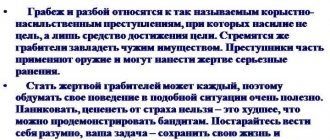Robbery is a crime against the constitutional rights and freedoms of a person, for which criminal liability and punishment are established by the court.
Punishment for this criminal act is determined in accordance with the provisions of Article 162 of the Criminal Code of the Russian Federation. Here are 4 points with an established preventive measure - without qualifying signs and with various forms of qualification.
Responsibility under the law in accordance with Art. 162 of the Criminal Code of the Russian Federation
Next, we will consider what punishment is provided and how many years are given for different types of this offense.
Without qualifying features
For a simple attack on a victim, punishment is provided in accordance with paragraph 1 of Article 162 of the Criminal Code of the Russian Federation, in the following amounts:
- Forced labor for 5 years or imprisonment in a secure institution for up to 8 years.
- Additionally, fines in the amount of 500 thousand rubles or in the amount of the person’s earnings (other income) for a period of up to three years may be imposed.
Forced labor is assigned at the place where the convicted person is distributed by the court. Stay in places of deprivation of liberty can be carried out in general regime correctional colonies. Sometimes - in penal colonies, if there are enough mitigating grounds in a robbery case.
With qualifying features
Primary qualification occurs when the offender acts alone, but during the attack uses a weapon that he uses against the victim, causing him bodily harm of varying degrees of severity. If a weapon is not used, but is used as a threat and serves the purpose of intimidating the person from whom valuables are taken, the qualification also applies.
In addition, the use of weapons means the use of any improvised objects that can be used to hit the victim of a crime or suppress her , causing psychological violence. Such items could be:
- broken bottles;
- sticks of various lengths and thicknesses;
- stones and bricks;
- iron rods and similar items.
If there are no weapons, but there are two or more criminals, then this form of qualification, corresponding to paragraph 2 of Article 162, also comes into force. Here, such a nuance as conspiracy or preliminary planning of robbery by a group of persons is taken into account.
If the second offender joined in the commission of a crime spontaneously, already in the process of committing it, qualifications for the main offender may not apply if he did not ask for help in committing the attack. Based on clause 2, the punishment is imposed in the following amount:
- Imprisonment for up to 10 years.
- Additionally (at the discretion of the court), a fine of up to 1 million rubles or in the amount of the income of the convicted person for a period of up to 5 years may be imposed, as well as subsequent restriction of freedom for up to 2 years. Additional measures may not apply.
In this case, isolation on the territory of the colony settlement is already excluded.
Criminals are placed in general and sometimes strict regime colonies. The qualification of the crime under paragraph 3 of this article provides for robbery during illegal entry :
- in the victim’s home;
- to the warehouse from which the property was seized;
- to another premises from which property or money was stolen (shop, office, entertainment venue, etc.).
Or – when it is a known fact for the criminals that the attack promises the seizure of money and/or valuables on a large scale. In criminal law, this amount (with the exception of some articles, which does NOT include robbery) is considered to be an amount over 250 thousand rubles. This paragraph provides for the following criminal penalties:
- Imprisonment for a term of 7-12 years.
- Additionally, a fine of up to 1 million rubles or in the amount of the income of the convicted person for up to 5 years and/or restriction of freedom for up to 2 years may be imposed.
Such terms of imprisonment are mainly carried out in high-security zones, with the possibility of switching to a general regime after half the term of imprisonment.
The maximum type of qualification is specified in paragraph 4 of Article 162 . Here, criminal liability is aggravated by the following circumstances:
- In case of robbery by an organized group of persons by prior conspiracy. An organized group is understood as a stable criminal entity that commits robbery attacks and consists of two or more people.
- Robbery on an especially large scale. A particularly large amount in the Criminal Code of the Russian Federation is considered to be an amount of money or the total value of stolen goods from 1 million rubles.
- When grievous bodily harm is caused to the victim at the time of the attack.
This type of crime carries a maximum penalty which is as follows:
- Imprisonment of the offender for a term of 8-15 years.
- Additional sanctions: a fine of up to 1 million rubles or in the amount of the convicted person’s income for up to 5 years, the possibility of restriction of freedom for up to 2 years.
The bulk of criminals are sent to maximum security colonies, sometimes to special security colonies, where they must serve two-thirds of their sentence, after which it is permissible to apply for a transfer to a more lenient level of punishment.
We talk about what qualifying criteria determine the type of robbery, what the corpus delicti may be and the liability provided for, we talk in a special material.
What is robbery? Definition, corpus delicti and criminal legal characteristics of robbery
Art. 162 provides a definition. Robbery is:
- attack;
- which is committed by a person in order to obtain someone else’s property;
- is accompanied by the use of violence or the threat of its use (if you run into a store with a pistol and shout: “Put $10,000 in a bag, otherwise I’ll shoot everyone!”, this is already considered robbery).
Will qualify under Art. 162 of the Criminal Code of the Russian Federation and those cases when you threaten with a dummy or an exact copy of a weapon, without intending to harm other people.
The subjective side is important here, i.e. so that the “victims” are aware of the danger.
If you burst into a store with a child’s water pistol and shout: “Put $10,000 in a bag, otherwise I’ll shoot everyone!”, such actions will not be classified as robbery (but they can be “stitched” for hooliganism).
The corpus delicti under Art. 162 of the Criminal Code of the Russian Federation for robbery
Lawyers work with 4 key points:
- subject (the one who commits the crime);
- object (social relations encroached upon by the perpetrator);
- subjective side (presence of guilt, intent);
- objective side (actions, consequences, the presence of a cause-and-effect relationship between them).
If at least 1 element “falls out” (is missing), then there will be no corpus delicti under Art. 162 of the Criminal Code of the Russian Federation. If there is no crime, there is no punishment (but this does not exclude the possibility that there are signs of other crimes and offences).
The subject of the crime under Art. 162 of the Criminal Code of the Russian Federation
You already know what the offense is for robbery. But who is responsible? What if the offender is 12, 14, 16 or 18 years old?
In Art. 20 of the Criminal Code specifies the age at which criminal liability begins. General - from the age of 16, but for a number of crimes there are exceptions.
Among them is Art. 162 of the Criminal Code of the Russian Federation . A person is subject to criminal liability for robbery from the age of 14 (as well as for theft, murder, robbery, extortion and others).
Of course, a person who, due to mental characteristics, could not understand the social danger of the act being committed will not be subject to criminal liability.
But this issue of incapacity at the time of the commission of the crime will still have to be proven (special examinations and studies are being carried out, so not everything is so simple).
Object of the crime under Art. 162 of the Criminal Code of the Russian Federation
The immediate objects of encroachment are social relations of property + human health.
Additionally, lawyers talk about the subject of robbery, i.e. property or right to property.
Roughly speaking, a criminal can encroach on:
- things;
- money;
- securities;
- cars;
- equipment and accessories;
- the right to own/use/dispose of property (for example, at gunpoint, the victim is forced to sign a deed of gift for an apartment, refusal of inheritance).
As a rule, property rights or obligations (when the owner owes money or does something) cannot be considered as an item. But at the same time, an article for extortion is possible, so try to be careful.
The subjective side of the crime under Art. 162 of the Criminal Code of the Russian Federation
There is only direct intent and selfish purpose here. The criminal is aware that he is using/threatening violence to take possession of property + desires it.
If a person has a different goal (for example, the use of violence to insult/humiliate the victim, to harm her life and health), then the qualification will be based on other articles of the Criminal Code.
The objective side of the crime under Art. 162 of the Criminal Code of the Russian Federation
Judicial practice and criminal law legislation follow a truncated composition model. This means that criminal liability arises simply for threatening or initiating the use of violence.
All you have to do is run into the bank with a pistol and shout: “Everyone, get down! This is a robbery!" - and art. 161 of the Criminal Code of the Russian Federation for “Robbery” immediately develops into Art. 162 of the Criminal Code of the Russian Federation for “Robbery” (of course, the penalties for the latter will be more severe).
Please note that situations where violence is used after taking possession of property in order to escape (for example, when a criminal “shoots back” from police officers) will not be classified as robbery.
Such actions are qualified depending on the resulting consequences. For example, theft + murder or fraud + causing grievous bodily harm and so on.
If, in order to take possession of property, poisonous substances and toxins are introduced into the victim’s body, leaving him in a helpless state, the actions are qualified as robbery.
If for the same purposes they used means that did not pose a particular danger to health (for example, sleeping pills), then we have robbery associated with violence.
The difference between robbery and extortion (Article 162 of the Criminal Code of the Russian Federation and Article 163 of the Criminal Code of the Russian Federation)
If you have not worked in the police, and all legal requirements and norms are a “dark forest” for you, the instructions will help you figure it out.
To make it easier to distinguish between the two compositions, we provide a special plate:
| Criteria for limiting lineups | Robbery under Art. 162 of the Criminal Code | Extortion under Art. 163 Criminal Code |
| Item | The culprit encroaches on property (money, cars, equipment, jewelry). | The criminal encroaches on property + rights to property + committing actions of a property nature. |
| Nature of violence | Physical force or the threat of its use (in this case, the violence must be dangerous to life and health). If you shout: “I will kill you!” and demand money, this could be robbery. | Threat of violence + threat of destruction of property + damage to property + dissemination of information. “Give me the money, otherwise I will tell everyone that you are pregnant from your neighbor!”, “You have 1,000 dollars, otherwise I will beat my son!”, “Give me 10,000! If not, then I’ll set the dacha on fire!” and so on. |
| Time of receipt of the item of encroachment | Right here and now. Roughly speaking, you threaten with a pistol in order to take away a bag of money in 2-3 minutes. Lawyers say that violence/the threat of violence is used to directly seize property. | In the future (in the long term). Also, violence can be used not right here and now, but in the future. |
In practice, you need a good lawyer who will help mitigate the punishment and avoid harsh sanctions.
The difference between robbery and robbery (Article 162 of the Criminal Code of the Russian Federation and Article 161 of the Criminal Code of the Russian Federation!)
| Criteria for limiting lineups | Robbery under Art. 162 of the Criminal Code | Robbery under Art. 161 Criminal Code |
| Method of violating property relations | Assault with the use of life-threatening violence (or with the threat of its use). | Use of violence/threat of violence that is not life-threatening. |
| Objective side design | Truncated. A crime is considered committed from the moment violence is used or a threat is made. In this case, it makes no difference whether the culprit was able to take possession of the property (or whether the police “tied him up”). | Material. The crime is considered completed from the moment of taking possession of the property. Otherwise, we are talking about preparation or attempt (which provides for more lenient sanctions and punishments). |
From what age are you attracted?
Regardless of qualifications, responsibility for this crime is assigned from the age of 14 years. Of course, in this case, the punishment is mitigated by the age of the guilty person, which is used by both the teenagers themselves and seasoned criminals who involve them in criminal acts. If juvenile offenders are given a sentence of imprisonment, they serve it in juvenile correctional facilities.
From our separate publications, you can also find out when robbery is classified as a committed crime, as well as how it differs from robbery and banditry.
Judicial practice in cases of robbery + crime statistics in the Russian Federation
Judicial practice is presented in Post. Plenum of the Supreme Court of the Russian Federation of December 27, 2002 N 29 “On judicial practice in cases of theft, robbery and robbery.” It is this document that judges are guided by when making decisions.
Reports “On the state of crime in Russia” appear on the website of the Ministry of Internal Affairs of the Russian Federation, which allow one to assess the number of violations, severity, and detection rate.
In January - June 2022, 993,000 crimes were registered on the territory of the Russian Federation, which is 3.6% less than in the same period last year (above you will find the “secret of reducing crime”).
Almost half of all registered crimes (or 49.5%) are theft of other people's property. If we talk specifically about robbery, then for the period January-June 2022, 3,700 cases were registered (which is 18.3% less than for the same period in 2017).
The website of the Ministry of Internal Affairs separately states that every tenth robbery attack (or 10.6%) involved illegal entry into a home, premises or other storage facility.
The main points presented in the Post. Pl. Supreme Court of the Russian Federation dated December 27, 2002 N 29 entitled “On judicial practice in cases of theft, robbery and robbery”:
- A person who organized a crime or persuaded persons not subject to criminal liability to commit it is recognized as a perpetrator.
- Committing 2, 3, 5 or more robberies does not entail additional qualifications and more severe penalties. Sanctions are established for each crime separately (and then for their totality). More detailed information is provided in Art. 17 of the Criminal Code of the Russian Federation.
- A sign of illegal entry into a home/premises/storage is not enough. The court needs to find out :
- what is the purpose of the penetration;
- when the intent to seize property arose. If a person was in the home/premises/storage legally (and not with criminal intent), and then committed theft/robbery/robbery, then there is no sign of “breaking into the home/premises/storage”! For example, it will not happen if the victim invites the criminal to visit, drinks alcohol, and the criminal then decides to “take” jewelry/equipment/antiques. There will be no sign of penetration even if the owners of shared property “pick” each other’s hoes/slippers/mugs/pots.
It would not be amiss to study the appellate definition of Moscow. City Court dated May 13, 2013 in case No. 10-2889, Federal Law “On Weapons”, post. Government of the Russian Federation dated August 17, 2007 N 522 entitled “On approval. Rules for determining the severity of harm caused to health,” order of the Min. healthcare and social development of the Russian Federation dated April 24, 2008 N 194n.
If an armed attack is committed for the purpose of theft
The Supreme Court comments in detail on the provision on committing a robbery with the use of weapons or other objects that can be used as weapons.
So, every time the courts must involve experts in order to investigate whether this or that object is a weapon. The Resolution provides a definition of objects, which should be understood as objects of the material world that can be used to cause “dangerous violence,” as well as the threat of causing such violence (knife, saw, bat, etc.).
We also note that if V. and G. decided to commit a robbery, during which only V. used a pistol, then both V. and G. are subject to liability under Part 2 of Art. 162 of the Criminal Code of the Russian Federation as co-executors.
The following situations are of interest:
- Let's imagine that A., wanting to steal property from B., threatens him with a toy pistol. At the same time, A. understands that such a toy will not cause any harm to B., he uses it to intimidate. In this case, we will qualify A.’s actions under Part 1 of Art. 162 of the Criminal Code of the Russian Federation, and not under Part 2. Resolution No. 29 states that if a person uses an unusable or unloaded weapon to make a threat, as well as objects that imitate weapons, then his actions fall under Part 1 of Art. 162 of the Criminal Code of the Russian Federation.
- Another qualification will be if B. understood that the gun was a toy. In this case, A.’s actions are regarded as robbery (Article 161 of the Criminal Code of the Russian Federation).
- If A., wanting to steal property from B., uses an animal (for example, a Rottweiler) to attack, which poses a danger to the life or health of B. Such actions are qualified under Part 2 of Art. 162 of the Criminal Code of the Russian Federation.
Recommended reading:
The concept of robbery, signs and assigned punishments
Robbery: corpus delicti
Forms of complicity in robbery










